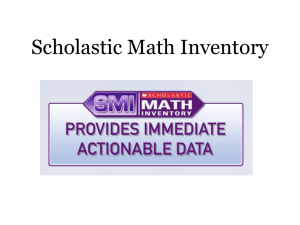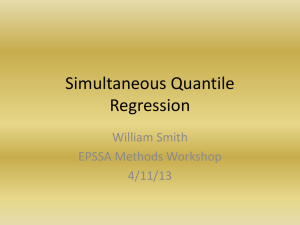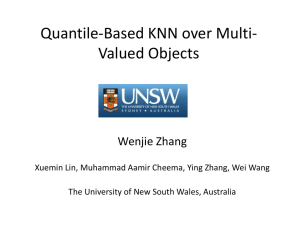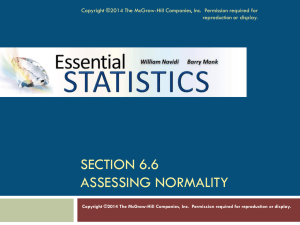Employment Reallocation and Unemployment Revisited: A Quantile
advertisement
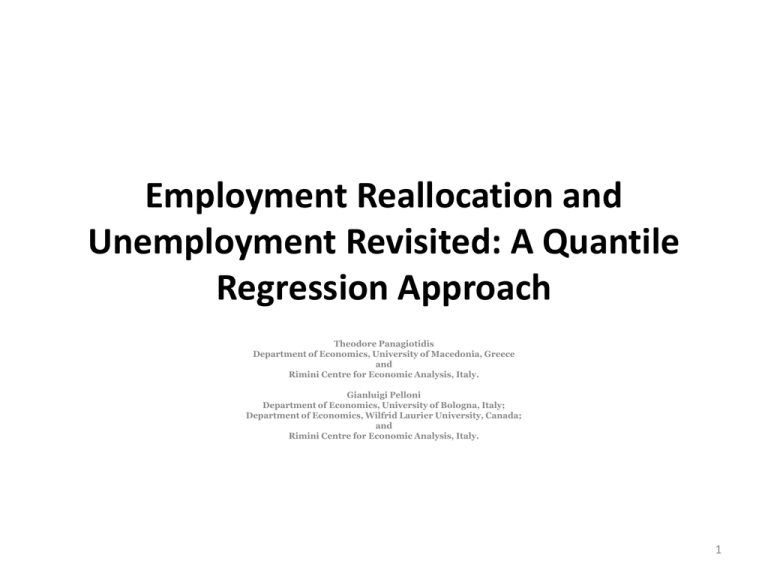
Employment Reallocation and Unemployment Revisited: A Quantile Regression Approach Theodore Panagiotidis Department of Economics, University of Macedonia, Greece and Rimini Centre for Economic Analysis, Italy. Gianluigi Pelloni Department of Economics, University of Bologna, Italy; Department of Economics, Wilfrid Laurier University, Canada; and Rimini Centre for Economic Analysis, Italy. 1 Introduction • Intersectoral labour reallocation as a triggering force of aggregate unemployment fluctuations. • An aggregate shock → firms to lay off workers temporarily → changes in aggregate employment and unemployment. • Sector-specific shocks, affecting the allocation of demand across sectors, → intersectoral movements of workers → the time-consuming processes of searching, retraining and relocating → could also alter the levels of (un) employment (Lilien, 1982a). 2 Introduction • Up to 1980’s aggregate shocks seen the driving force of unemployment cycles. • Lilien(1982a) Sect. Shifts Hypothesis. : reallocation shocks →macroeconomic effects. • Changes in demand composition operate as the driving force of unemployment fluctuations. Idiosyncratic shocks bring flows of job reallocation from declining sectors to expanding ones 3 Literature • Lilien (1982a): reduced form equation with dispersion index: σt = [j (N j,t / N t) ( Δ ln N j,t - Δln Nt)2]1/2 • Criticism: Lilien (1982b, WP); Abraham and Katz (1986). • Literature Review: Gallipoli & Pelloni (2008) 4 Methodology • Most of the existing literature focuses on the conditional mean response (LRM). The latter assumes symmetry and linearity. • Literature approached the issues by employing nonlinear models both at univeriate and multivariate level. • This paper is the first attempt to investigate this issue by quantile regression (QR): assymetry 5 • QR (Koenker and Basset, 1978) is a tool that allows us to model distributions. • Starting point for QRM → conditional quantile function (CDF). • The CDF of Yi at quantile τ given a vector of covariates Xi is given by: 1 y Q (Yi / X i ) F ( / X i ) 6 • Where F ( / X ) is the distribution function of Yi at y, conditional on X . When τ=0.10 Q (Yi / X i ) describes the lower decile of Yi given X . • Reduced form of the estimated model: 1 y i i i Q (ui / X i ) 0 ( ) 1 ( )s 2 ( )D 3 ( )LM 4( )LE • ut = ln(Ut/(1- Ut)) logistic transfromation 7 .030 .025 .020 .015 .010 .005 .12 .000 .10 .08 .06 .04 .02 50 55 60 65 70 75 80 85 Unemployment rate 90 95 00 05 10 σ 8 UNRATE LOGISUNRATE 30 1.6 1.4 25 1.2 1.0 Density Density 20 15 0.8 0.6 10 0.4 5 0.2 0 .01 .02 .03 .04 .05 .06 .07 .08 .09 .10 .11 .12 0.0 -4.0 -3.8 -3.6 -3.4 -3.2 -3.0 -2.8 -2.6 -2.4 -2.2 -2.0 -1.8 9 Quantile Process Estimates (95% CI) C SIGMA_PURGED2 -2.7 80 -2.8 60 -2.9 40 -3.0 20 -3.1 0 -3.2 -20 -3.3 -40 0.0 0.1 0.2 0.3 0.4 0.5 0.6 0.7 0.8 0.9 1.0 0.0 0.1 0.2 0.3 0.4 Quantile 0.5 0.6 0.7 0.8 0.9 1.0 0.7 0.8 0.9 1.0 Quantile FEDERALDEFICIT DLAMBSL -7 4 -8 2 -9 0 -10 -2 -11 -4 -12 -13 -6 0.0 0.1 0.2 0.3 0.4 0.5 0.6 0.7 0.8 0.9 1.0 Quantile 0.0 0.1 0.2 0.3 0.4 0.5 0.6 Quantile DLCPI_ENERGY 1 0 -1 -2 -3 -4 -5 0.0 0.1 0.2 0.3 0.4 0.5 Quantile 0.6 0.7 0.8 0.9 1.0 10 Quantile Process Estimates (95% CI) C SIGMA_PURGED2(-6) -2.6 80 -2.7 60 -2.8 -2.9 40 -3.0 20 -3.1 0 -3.2 -3.3 -20 0.0 0.1 0.2 0.3 0.4 0.5 0.6 0.7 0.8 0.9 1.0 0.0 0.1 0.2 0.3 0.4 Quantile 0.5 0.6 0.7 0.8 0.9 1.0 0.7 0.8 0.9 1.0 Quantile FEDERALDEFICIT(-6) DLAMBSL(-6) -5 4 -6 3 -7 2 -8 1 -9 0 -10 -1 -11 -2 0.0 0.1 0.2 0.3 0.4 0.5 0.6 0.7 0.8 0.9 1.0 Quantile 0.0 0.1 0.2 0.3 0.4 0.5 0.6 Quantile DLCPI_ENERGY(-6) 2 1 0 -1 -2 -3 0.0 0.1 0.2 0.3 0.4 0.5 0.6 0.7 0.8 0.9 1.0 Quantile 11 Quantile Process Estimates (95% CI) C SIGMA_PURGED2(-12) -2.4 50 40 -2.6 30 -2.8 20 -3.0 10 0 -3.2 -10 -3.4 -20 0.0 0.1 0.2 0.3 0.4 0.5 0.6 0.7 0.8 0.9 1.0 0.0 0.1 0.2 0.3 0.4 Quantile 0.5 0.6 0.7 0.8 0.9 1.0 0.7 0.8 0.9 1.0 Quantile FEDERALDEFICIT(-12) DLAMBSL(-12) -2 6 -4 4 -6 2 -8 0 -10 -12 -2 0.0 0.1 0.2 0.3 0.4 0.5 0.6 0.7 0.8 0.9 1.0 Quantile 0.0 0.1 0.2 0.3 0.4 0.5 0.6 Quantile DLCPI_ENERGY(-12) 5 4 3 2 1 0 -1 0.0 0.1 0.2 0.3 0.4 0.5 Quantile 0.6 0.7 0.8 0.9 1.0 12 What happens if we replace the logistic transformation with unemployment rate? Quantile Process Estimates (95% CI) C SIGMA_PURGED2 .065 4 .060 3 .055 2 .050 1 .045 0 .040 -1 .035 .030 -2 0.0 0.1 0.2 0.3 0.4 0.5 0.6 0.7 0.8 0.9 1.0 0.0 0.1 0.2 0.3 0.4 Quantile 0.5 0.6 0.7 0.8 0.9 1.0 0.7 0.8 0.9 1.0 Quantile FEDERALDEFICIT DLAMBSL -.3 .2 -.4 .1 -.5 .0 -.6 -.1 -.7 -.8 -.2 0.0 0.1 0.2 0.3 0.4 0.5 0.6 0.7 0.8 0.9 1.0 Quantile 0.0 0.1 0.2 0.3 0.4 0.5 0.6 Quantile DLCPI_ENERGY .05 .00 -.05 -.10 -.15 -.20 0.0 0.1 0.2 0.3 0.4 0.5 Quantile 0.6 0.7 0.8 0.9 1.0 13 Quantile Process Estimates (95% CI) C SIGMA_PURGED2(-6) .07 5 4 .06 3 .05 2 1 .04 0 .03 -1 0.0 0.1 0.2 0.3 0.4 0.5 0.6 0.7 0.8 0.9 1.0 0.0 0.1 0.2 0.3 0.4 Quantile 0.5 0.6 0.7 0.8 0.9 1.0 0.7 0.8 0.9 1.0 Quantile FEDERALDEFICIT(-6) DLAMBSL(-6) -.35 .24 .20 -.40 .16 .12 -.45 .08 -.50 .04 .00 -.55 -.04 -.60 -.08 0.0 0.1 0.2 0.3 0.4 0.5 0.6 0.7 0.8 0.9 1.0 Quantile 0.0 0.1 0.2 0.3 0.4 0.5 0.6 Quantile DLCPI_ENERGY(-6) .10 .05 .00 -.05 -.10 -.15 0.0 0.1 0.2 0.3 0.4 0.5 Quantile 0.6 0.7 0.8 0.9 1.0 14 Quantile Process Estimates (95% CI) C SIGMA_PURGED2(-12) .08 4 .07 3 .06 2 .05 1 .04 0 .03 -1 0.0 0.1 0.2 0.3 0.4 0.5 0.6 0.7 0.8 0.9 1.0 0.0 0.1 0.2 0.3 0.4 Quantile 0.5 0.6 0.7 0.8 0.9 1.0 0.7 0.8 0.9 1.0 Quantile FEDERALDEFICIT(-12) DLAMBSL(-12) -.2 .4 -.3 .3 -.4 .2 -.5 .1 -.6 .0 0.0 0.1 0.2 0.3 0.4 0.5 0.6 0.7 0.8 0.9 1.0 Quantile 0.0 0.1 0.2 0.3 0.4 0.5 0.6 Quantile DLCPI_ENERGY(-12) .4 .3 .2 .1 .0 -.1 0.0 0.1 0.2 0.3 0.4 0.5 0.6 0.7 0.8 0.9 1.0 Quantile 15 Conclusions • Assymetry in the relationship revealed. • The higher the unemploeyment the more reallocation is taking place. • Deficit: upward sloping, negative and significant • Money: singificant at the 12 month lag only when unemployment is high. • Energy: not singificant 16
